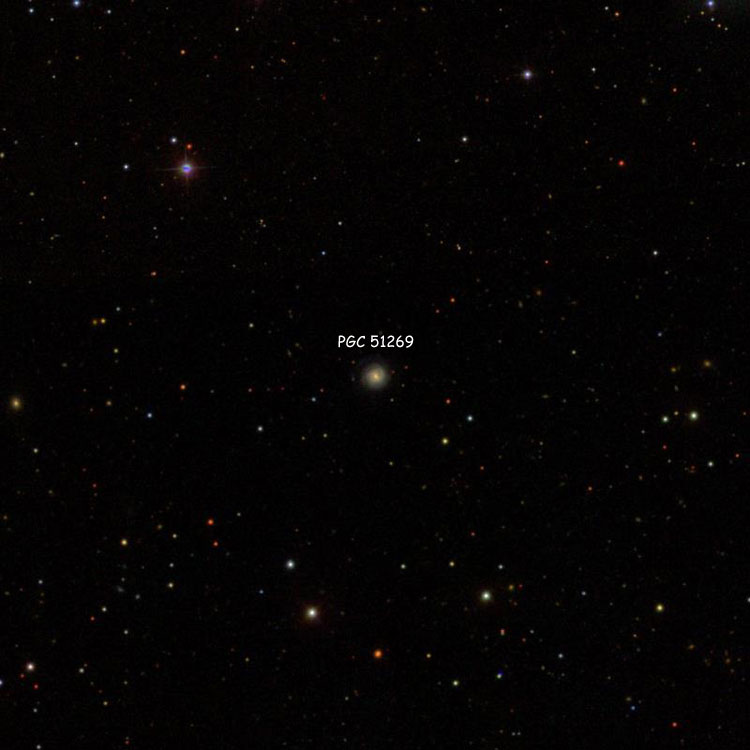Page last updated Aug 5, 2022
PGC 51214 (with PGC 200317 = Arp 45)
PGC 51214 = A magnitude 15.0(?) spiral galaxy (type SAB(rs)b?) in Bo÷tes (RA 14 19 55, Dec +51 53 38)
PGC 200317 = A magnitude 15.5(?) spiral galaxy (type Scd? pec) in Bo÷tes (RA 14 20 01, Dec +51 52 53)
PGC 51214 and PGC 200317 comprise Arp 45, an example of a spiral galaxy with a fainter companion.
PGC Designation Note: The current LEDA catalog lists the fainter galaxy as PGC 51214 and the brighter as PGC 200317, while NED reverses the PGC designations. A Vizier catalog search states that the brighter galaxy is PGC 51214, so that is more likely to be correct and the current LEDA listing a transposition error, and I have used that interpretation to label the images below (it also makes more sense, as the first 77141 PGC listings belong to the original catalog and are generally brighter than those with larger numbers, which represent supplementary catalogs).
Physical Information: (Note to self: Need to update for relativistic corrections, Hubble constant, etc). Given the designations as stated, PGC 51214 has a recessional velocity of 8705 km/sec, and an apparent size of 0.7 by 0.5 arcmin. PGC 200317 has a recessional velocity of 8770 km/sec, and an apparent size of 0.4 by 0.3 arcmin. These numbers imply that the pair is about 410 million light years away, probably gravitationally bound, and that the larger galaxy is about 85 thousand light years across and the smaller about 45 thousand light years across.

Above, a 12 arcmin wide SDSS image centered on PGC 51214 and 200317, which comprise Arp 45
Below, a 2.4 arcmin wide SDSS image of the pair
Note: the exaggeratedly red star which dominates the image is magnitude 10.5
PGC 51269
(= CGCG 047-019)
Discovered (Apr 16, 1878) by John Dreyer, but a "notngc" object
A magnitude 15(?) galaxy (type (R'?)SABb?) in Virgo (RA 14 20 56.6, Dec +03 52 18)
Historical Information: As noted in the entry for NGC 5560, this galaxy was discovered by Dreyer while examining the triplet of galaxies that became Arp 286, but was never published in the NGC because he only made a rough estimate of its position (and a sketch of the region, published in Lord Rosse's 1880 paper, which allowed Yann Pothier to find Dreyer's observation), making it a so-called "notngc" object, meaning an object discovered prior to the publication of the NGC, but never included in it or any of Dreyer's subsequent works.
Physical Information: Based on a recessional velocity relative to the Cosmic Background Radiation of 10860 km/sec (and H0 = 70 km/sec/Mpc), a straightforward calculation indicates that PGC 51269 is about 505 million light-years away. However, for objects at such distances we should take into account the expansion of the Universe during the time it took their light to reach us. Doing that shows that the galaxy was about 485 million light-years away at the time the light by which we see it was emitted, about 490 to 495 million years ago (the difference between the two numbers being due to the expansion of the intervening space during the light-travel time). Given that and its apparent size of about 0.55 by 0.55 arcmin (from the images below), the galaxy is about 75 to 80 thousand light-years across. Both LEDA and NED list PGC 51269 as a Seyfert galaxy (type Sy 1).
Final Note: The size and classification shown above are based on an apparent partial ring outside the bright central part of the galaxy; if the ring is a photographic artifact and the central galaxy is all that really exists, then the (R'?) should be removed, the apparent size changed to 0.4 by 0.4 arcmin, and the physical size to 55 to 60 thousand light-years.

Above, a 12 arcmin wide SDSS image centered on PGC 51269
Below, a 17.5 arcmin wide SDSS image showing the galaxy and the triplet of galaxies that led to its discovery
(NGC 5560, 5566 and 5569, which comprise Arp 286)

Below, a 1.0 arcmin wide SDSS image of PGC 51269

PGC 51472 (= PGC 2246250 = "DDO 190")
Discovered (1959) by Sidney van den Bergh
A magnitude 12.8 dwarf irregular galaxy (type IAm?) in Bo÷tes (RA 14 24 43.6, Dec +44 31 34)
Note About DDO Designation: The press release for the HST image shown below only refers to the galaxy as DDO 190, referring to its inclusion in a catalog of dwarf galaxies observed at the David Dunlap Observatory in Canada.
Warning About Possible Misidentification: This object is also known as UGC 9240, but I was alerted to its existence by a question about a mislabeled image which called it UGC 2940; so it is possible that similar errors may exist.
Physical Information: The galaxy's recessional velocity of 150 km/sec is too small to be a reliable indicator of its Hubble distance, but redshift-independent distances estimates range from 9 to 12 million light years, the lower value being the one used in the HST press release. Given that and its apparent size of about 2.0 by 1.9 arcmin (from the images below), it is about 5 thousand light years across (hence its classification as a dwarf galaxy). It is thought to be a loosely bound member of the M94 group of galaxies, with its nearest neighbor (DDO 187) being about 3 million light years from PGC 51472. While most of the stars in the galaxy are red dwarfs, there are a substantial number of younger, hot blue young stars scattered throughout it, and even a notable region of ionized gas heated by young star clusters on its southern rim.

Above, a 12 arcmin wide SDSS image centered on PGC 51472
Below, a 2.5 arcmin wide SDSS image of the galaxy

Below, a 2.5 arcmin wide HST image of the galaxy (Image Credit ESA/Hubble & NASA)

|